Submit a Manuscript to the Journal
Journal of Maps
For an Article Collection on
Structural Mapping for Understanding the Dynamics of the Earth System
Manuscript deadline


Article collection guest advisor(s)
Dr Maria Di Rosa,
Department of Earth Sciences, Univeristy of Pisa, Italy
Professor Laura Crispini,
Department of Earth, Environmental and Life Sciences, University of Genova, Italy
Professor Kamil Ustaszewski,
Friedrich Schiller University Jena, Germany
Structural Mapping for Understanding the Dynamics of the Earth System
Mapping and interpreting tectonic structures is a key step in understanding crustal deformation processes at various structural levels, and thus fundamental for representing geometrically admissible and geologically viable 4D deformation models. The identification, characterization and visualization of the surface deformation patterns at various scales, combined with geospatial databases, allow a better understanding of the evolution of the Earth's dynamic systems.
Geological maps provide essential information not only about the distribution, nature, and geometrical relationships of rock units, but provide 3D information about the spatial distribution and cross-cutting relationships of geological structures at various scales. Structural geological maps are fundamental tools not only for interpreting the geological history and tectonic processes at the regional scale of an area, but also for their contribution to natural hazard assessment strategies and fostering better georesource management, land use planning and environmental protection.
The introduction of digital geological mapping and the rapid evolution of spatial visualisation techniques represent a significant advancement that offers advanced functionality and features that are rapidly transforming the way geo-structural data are collected, analysed and represented. The integration of geostructural maps with geospatial databases and platforms is challenging to place the structures in their geological context in 4-dimensions. The collection of structural data leverages traditional direct techniques such as fieldwork and modern methodologies such as InSAR and drone surveying, and is also supported by indirect methodologies from geophysics such as the analysis of underwater or inaccessible surfaces.
This Article Collection hence aims to collect contributions on the mapping of geological structures in order to reinforce within the geoscientific community the indispensable skill of geological mapping as a basis for understanding any kind of geoscientific problems, featuring articles focused on the geostructural analysis of any surface of the Earth system providing either original structural maps of still uncovered areas or proposing new methodologies or applications of geostructural mapping featuring the solution of geological problems.
Detailed studies of small areas at very high resolution, as well as geological maps on a regional scale, are welcome to contribute to the understanding of past, recent or current deformation history.
Subtopics such as lithostratigraphy, petrology, marine geology, planetary geology, georesources, geomorphology, natural hazard, and seismotectonics may be included in the geological maps submitted for this Article Collection, as long as they are linked to the structural or tectonic setting of the mapped area. Care should be taken in the representation of geological structures and the overall layout of the Main Map, in line with the high standards of contributions expected by Journal of Maps.
Article Collection key terms:
- Geological mapping
- Structural analysis
- Ductile and brittle deformation patterns
- Earth System dynamics
Article Collection Guest Advisors
Dr Maria Di Rosa trained as a structural geologist in Pisa, Grenoble, and Paris, and received her Ph.D. in 2019 at the University of Florence. Her main research interests include the tectono-metamorphic history of Alpine Corsica, the Ligurian and Western Alps, the Northern Apennines, Northern Anatolia, and the Makran belt. She has participated as a co-teacher in geological mapping courses in Italy, France, Albania, Sweden, and Uzbekistan, and currently teaches Tectonics at the University of Pisa.
Professor Laura Crispini is Full Professor of Structural Geology at the University of Genova (Italy). She obtained her PhD in Earth Sciences in 1995. Her expertise includes onshore and offshore geological mapping, tectonics and the connections between geology and geophysics; areas of study include Western Alps, Northern Apennine, Oman, Antarctica and the East Pacific Rise. She has taken part in scientific expeditions to Antarctica, and she was part of the core logging teams in International Ocean Discovery Program (IODP) and International Continental Drilling Program (ICDP) expeditions.
Professor Kamil Ustaszewski has been Professor of Structural Geology at the University of Jena since 2013. He obtained his Ph.D. at the University Basel (Switzerland) in 2004. His research interests focus on the tectonics and related sedimentary, magmatic, metamorphic, but also geomorphological processes mostly along converging plate margins. He has worked in different orogens such as Taiwan, the Dinarides and Hellenides, the Zagros and the Alps. Detailed field work, ideally complemented by geological mapping, forms an indispensable backbone of all his projects.
All manuscripts submitted to this Article Collection will undergo a full peer-review; the Guest Advisors for this Collection will not be handling the manuscripts
Please review the journal scope and author submission instructions prior to submitting a manuscript.
The deadline for submitting manuscripts is 30 September 2025.
Please contact Alex Johnson at alex.johnson@tandf.co.uk with any queries and discount codes regarding this Article Collection.
Please be sure to select the appropriate Article Collection from the drop-down menu in the submission system.
Please select 'Science' from the list of available sections during submission. Failure to select the appropriate Article Collection or Section name can result in delays.
The Guest Advisors for this Article Collection have indicated no conflict of interest
Benefits of publishing open access within Taylor & Francis
Global marketing and publicity, ensuring your research reaches the people you want it to.
Article Collections bring together the latest research on hot topics from influential researchers across the globe.
Rigorous peer review for every open access article.
Rapid online publication allowing you to share your work quickly.
Submission Instructions
All manuscripts submitted to this Article Collection will undergo desk assessment and peer-review as part of our standard editorial process. Guest Advisors for this collection will not be involved in peer-reviewing manuscripts unless they are an existing member of the Editorial Board. Please review the journal Aims and Scope and author submission instructions prior to submitting a manuscript.

